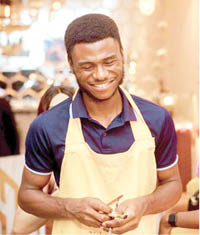I don’t limit myself to a specific style – Oche
Cletus Okpe Oche is a visionary artist whose journey began with a childhood passion for graphic novels and comics, evolving into a profound exploration of everyday life through art. In this Interview with Daily Trust on Sunday, Oche speaks on his creative process and his evolution as an artist. What initially sparked your interest in […]

02sun20
Cletus Okpe Oche is a visionary artist whose journey began with a childhood passion for graphic novels and comics, evolving into a profound exploration of everyday life through art. In this Interview with Daily Trust on Sunday, Oche speaks on his creative process and his evolution as an artist.
What initially sparked your interest in art, and how has that evolved over time?
As far back as I can remember, my interest in art as a child was ignited by reading and drawing from graphic novels and action comics. I tried to imitate the artists of these books from that young age but after a while, I realised I had to tell my own stories in my own way which was how my interest shifted to the everyday life around me.
Can you walk us through your creative process? How do you find inspiration and translate it into your work?
Basically, my creative process begins with observation to receive an idea. Then, I do tons of sketches to flesh it out before going on the paper for the final piece but I always leave room for changes even during the last charcoal or pen strokes. I surround myself with music, books and documentaries also, as my sources of inspiration.
Are there any recurring themes or motifs in your art? What do they represent to you?
My works usually contains the human figure. Currently, I find it to be one of the loudest ways to speak to my audience. Secondly, I love the use of gold paints. It usually represents something inside of us.
How do you balance experimentation and sticking to your signature style in your artwork?
Although I love experimentation, I try to make the conscious effort not to constrain myself to a particular style because as the spirit of every artist, which is always in the artwork, changes so does everything else.
Can you share a particularly memorable or meaningful moment you’ve experienced as an artist?
One memorable experience was when a child in my neighbourhood walked up to me and said “I want be an artist and draw like you”. At that moment, I realised that as I was inspired once upon a time as an artist, I have been able to do the same.
What role do you think art plays in society, and what message or impact do you hope your work conveys?
I believe art holds the society together. It’s like the soul in everything. As a matter of fact, our genuine experiences are shared through it. I want my work to help people realise the truth about what really matters in life and that we should always strive for it and so in the process, become better people.
Do you have any rituals or habits that help you get into a creative mind-set?
One habit that helps me is staring at a blank wall when I walk across the street. Staring at a blank canvas or paper doesn’t really work, just the walls apparently.
How do you handle creative blocks or periods of self-doubt in your artistic journey?
I have come to embrace both experiences as part of my artistic journey. I don’t create works in spite of them, but because of them especially self-doubt which is constantly like a mountain I must climb, and I love the challenge. For creative block, I simply step away from the studio and art materials. I see it as a self-recharging and recycling period rather than a period of gruelling blockage. I don’t burden myself with the need to always be creative.
Are there any artists, past or present, who have significantly influenced your work?
Of course there are. To mention a few; Arinze Stanley, Kelvin Okafor, Jono Dry, and Kim Jung Gi.
If you could collaborate with any artist, living or deceased, who would it be and why?
For collaborations, Kim Jung Gi is my choice. Although he is deceased, I love how he could create imaginative and complex scenes on the spot and tell stories almost effortlessly with his techniques and humour especially.
How do you think technology and digital platforms have influenced the way art is created and consumed today?
Technology like any other traditional tool for any good artist can serve to produce an artwork. In addition to the increase in speed it offers, it has opened up new ways for artists to experiment their ideas like digital transfer of images, laser tech for engraving and so on. Also, the use of digital platforms to share artworks have made it possible for people to experience much more art pieces and for artists too to have a broader audience. The drawback I see is that due to the large amount of works available and the low attention span of people nowadays, it’s hard to get the full immersive experience the physical works will give in real life.
What advice would you give to aspiring artists who are just starting on their creative path?
From my experience, as an artist, you should take a full dive into the chaos of ideas and forget about the need for a style. You must strive to be genuine and authentic in your creative process and not create to satisfy people’s expectations. Finally, practice, practice and practice like your life depends on it, because in a way it does.
